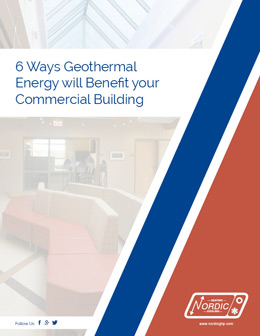Commercial geothermal heat pumps are typically chosen for new commercial buildings. These could be schools, farmers’ markets, health centers, or community centers. While every commercial building is unique, there are three typical methods of implementation that we see regularly for commercial heat pump installations. Let’s walk through them below:
Full Capacity Heating and Cooling
With this system, geothermal heat pumps provide full service heating and cooling to your commercial building. The heat pumps collect heat from an underground collector system, and transfer it into the commercial building via radiant in-floor heat.
Typically the underground collector system consists of a series of vertical boreholes that are drilled under what will become the parking lot, recreational field, or boardwalk. Once the boreholes are installed, they can be covered and because they are a closed system, there is little chance they will need to be accessed in the future. Vertical boreholes are beneficial because they take up less space that a horizontal ground loop, making them ideal for city applications and large commercial buildings that require a large underground collector system.
Once the heat is collected, our large commercial water-to-water heat pumps will transfer the heat to your commercial building through a series of radiant in-floor zones. In the summer time, the system reverses and cooling is offered via hydronic fan coils. Our commercial heat pumps can also produce domestic hot water, saving you money on your water heating bills.
Simultaneous Heating and Cooling
Simultaneous heating and cooling is a relatively new design method that is being implemented in large commercial buildings that have a need for both heating and cooling at the same time. An example of simultaneous heating and cooling requirement in buildings within close proximity would be an ice rink that needs to be cooled and offices or a swimming pool that also needs to be heated. It’s also useful in buildings that house large amounts of electronics that require cooling while the offices require heating.
This innovative design allows both heating and cooling to take place at the same time using heating-only commercial W Series heat pumps, simply by taking advantage of both sides of the heat pump. This virtually doubles the system efficiency, taking it from an average COP of 4.0 to 8.0. Doubling the COP will significantly decrease operating costs, and boost the system’s eco friendly efficiency. This system has an added benefit of being able to remove heat from locations that require cooling and placing it in locations that require heating without using the ground loop at all. This eliminates the need to operate the ground loop circulators, further increasing the system’s efficiency.
Simultaneous heating and cooling is by far the most efficient way to heat and cool a building, here’s how it works:
With a simultaneously heating and cooling system, multiple heat pumps are linked in parallel between a hot and cold buffer tank. The hot buffer tank connects to the heating zones while the cold buffer tank connects to the outdoor side of the heat pump and the cooling zones. The heat pumps absorb heat from the cold buffer tank and reject this heat along with the compressor energy into the hot buffer tank.
Waste Heat Recovery
Using heat pumps to recover waste, or leftover heat from sewage, grey water or other industrial processes is becoming a popular way to eliminate the waste heat that goes down the drain in your commercial building every day. Instead of gathering heat from the ground, waste heat recovery heat pumps gather their heating from a clean incoming liquid. This liquid could be from any of the sources mentioned above, and is usually treated beforehand. The heat pump gathers the heat and then compresses it to raise the temperature. The heat is then transferred back into the building, usually in the form of domestic hot water.
Waste heat recovery heat pump installations have been successfully employed in a variety of situations and system sizes. Waste heat recovery works well in hotels, fish farms, multi-unit residential buildings, and large scale sewage treatment facilities.



